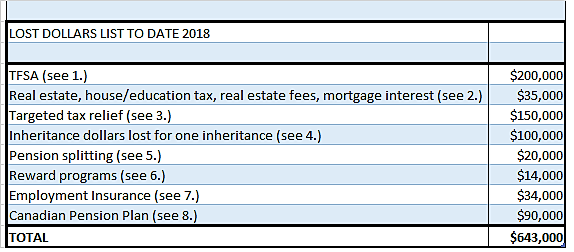FEE SCHEDULES WHERE FAMILIES PAY MUCH LESS AND FINANCIALLY DISCRIMINATE AGAINST SINGLES
These thoughts are purely the blunt, no nonsense personal opinions of the author and are not intended to provide personal or financial advice.
This post is a reproduction of an article that was put together in 2009. Even though the examples are several years old, nothing has changed where singles are consistently forced to pay more than families. Many more examples can be found to replace these examples.
EXAMPLE A:
Fee Schedule
- Standard Plan: Individual $65 Family $85
Premium Plan: Individual $100 Family $130
(Family is defined as two or more people and includes all members of a household)
Does this look like a fair plan? The following information shows that this fee schedule is for a patient registration form from a local family doctor. The fee schedule was put into place to cover uninsured services not covered by the provincial medical plan.. The uninsured services included:
- telephone consultations
- prescription renewals over the phone
- completion of insurance forms, sick notes
- medical supplies,
- completion of school/camp forms, daycare notes
- faxing/photocopying and transfer of medical records
- pre-employment certificate of fitness
- driver’s medical and physical examination form
- citizen and immigration report
- disability tax credit form
- travel cancellation form
- referral form for chiropractor and physiotherapy
- referral note chiropody and massage
- wart removal
The pay for service fee for any of these items ranged from low of $20.00 to high of $125.00. The Standard Plan fee covered partial services of sick note, faxing and photocopying of medical records, back to work note, pre-employment certificate of fitness, referral note for chiropractor and physiotherapy and referral note for chiropody and massage. The Premium fee covered all listed services.
THIS FEE SCHEDULE WAS RECOMMENDED BY THE PROVINCIAL MEDICAL ASSOCIATION
- QUESTION: Why are singles paying more than families in adult to adult person comparison? (note: assumption being made is that kids are FREE)
- QUESTION: Who will be using more services such as school/camp forms, daycare notes, sick notes (by virtue of fact there are more members who will be using these forms in a family? ANSWER: Families will be using more of these services, so why are singles paying more in proportion than families?
- QUESTION: Who will be using more of all of the services listed? ANSWER: Families will be using more of the services since there are more members in the family unit. So, why are singles paying more in proportion adult to adult in the family unit?
- QUESTION: Why are couples without kids and alternative lifestyle couples without kids (included under family category, not single category) allowed to benefit (pay less) over singles? They usually have two incomes, while singles only have one income.
SUGGESTION FOR A FEE SCHEDULE THAT PROMOTES EQUALITY AMONG ALL MEMBERS OF SOCIETY – form a plan that bases the fee on number of adults (kids would be free).
- Individual $65 – change to $50 for one adult (singles are one unit, only have one income)
- Family $100 – leave as $100. (This would ensure each adult in whatever family unit – husband/wife with kids and two incomes, husband/wife with no kids and usually two incomes, alternative lifestyle couples with/without kids and usually two incomes – would all be paying an equal amount per adult. All kids would be FREE. Singles would not be subsidizing families.
- Single Parent $50 – add new category (EVEN SINGLE PARENTS WITH KIDS ARE SUBSIDIZING FAMILIES WITH/WITHOUT KIDS AND ALTERNATIVE LIFESTYLE COUPLES WITH/WITHOUT KIDS. Charging for the adult only would ensure that single parents who usually only have one income would not be subsidizing members of any type of family unit. SINGLE PARENTS WITH KIDS AND ONE INCOME SHOULD NOT BE PLACED IN SAME CATEGORY AS FAMILY UNITS WITH MORE THAN ONE INCOME!
EXAMPLE B:
Local family sports center fee for yearly membership fee is :
- Family – $500 per year
- Single – $300 per year
Once again singles/single parents with kids and one income are subsidizing all types of family units as described above who usually have two incomes.
A more appropriate schedule would be to charge per adult:
- Family – $500 per year
- Individual – $250 per year
- Single parent with kids – $250 per year
EXAMPLE C:
Local library fee schedule for yearly membership is:
- Family – $20
- Adults (18+) – $15
A more appropriate schedule would be:
- Family – $20
- Individual – $10
- Single parent with kids $10
Many more examples can be given where singles/single parents with children are at a disadvantage compared to families. (I.e., weekly Superstore coupon worth $25 is given when $250 is spent. How can a single/single parent with kids even begin to spend $250 each week on one income?)
Above examples (just a few!! Out of many) show how the rich keep getting richer and how lower and middle income families benefit the most while individuals/single parents with kids and single incomes are the financial losers!!
The above recalculation of fee schedules did not take rocket science. It appears government and decision makers won’t or can’t use financial intelligence and simple mathematical statistical formulas to promote the financial rights and privileges for equality of all citizens regardless of marital status.
The irony of this recalculation is that the fee schedules based on adults may bring in slightly less revenue, and in some cases would even bring in more revenue while promoting financial equality.
This blog is of a general nature about financial discrimination of individuals/singles. It is not intended to provide personal or financial advice.


